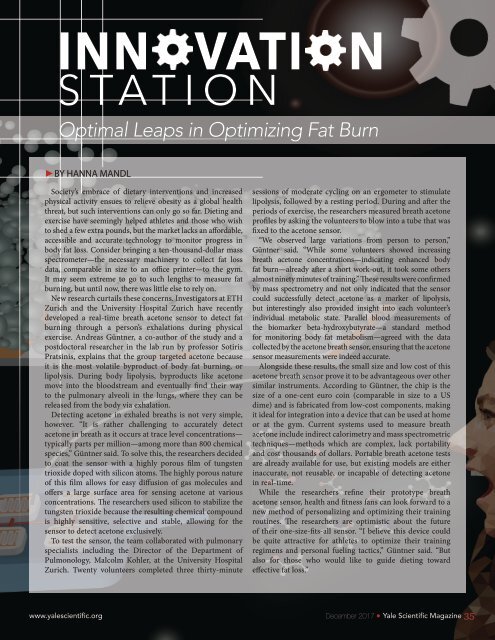YSM Issue 90.5
You also want an ePaper? Increase the reach of your titles
YUMPU automatically turns print PDFs into web optimized ePapers that Google loves.
INN VATI N<br />
STATION<br />
Optimal Leaps in Optimizing Fat Burn<br />
►BY HANNA MANDL<br />
Society’s embrace of dietary interventions and increased<br />
physical activity ensues to relieve obesity as a global health<br />
threat, but such interventions can only go so far. Dieting and<br />
exercise have seemingly helped athletes and those who wish<br />
to shed a few extra pounds, but the market lacks an affordable,<br />
accessible and accurate technology to monitor progress in<br />
body fat loss. Consider bringing a ten-thousand-dollar mass<br />
spectrometer—the necessary machinery to collect fat loss<br />
data, comparable in size to an office printer—to the gym.<br />
It may seem extreme to go to such lengths to measure fat<br />
burning, but until now, there was little else to rely on.<br />
New research curtails these concerns. Investigators at ETH<br />
Zurich and the University Hospital Zurich have recently<br />
developed a real-time breath acetone sensor to detect fat<br />
burning through a person’s exhalations during physical<br />
exercise. Andreas Güntner, a co-author of the study and a<br />
postdoctoral researcher in the lab run by professor Sotiris<br />
Pratsinis, explains that the group targeted acetone because<br />
it is the most volatile byproduct of body fat burning, or<br />
lipolysis. During body lipolysis, byproducts like acetone<br />
move into the bloodstream and eventually find their way<br />
to the pulmonary alveoli in the lungs, where they can be<br />
released from the body via exhalation.<br />
Detecting acetone in exhaled breaths is not very simple,<br />
however. “It is rather challenging to accurately detect<br />
acetone in breath as it occurs at trace level concentrations—<br />
typically parts per million—among more than 800 chemical<br />
species,” Güntner said. To solve this, the researchers decided<br />
to coat the sensor with a highly porous film of tungsten<br />
trioxide doped with silicon atoms. The highly porous nature<br />
of this film allows for easy diffusion of gas molecules and<br />
offers a large surface area for sensing acetone at various<br />
concentrations. The researchers used silicon to stabilize the<br />
tungsten trioxide because the resulting chemical compound<br />
is highly sensitive, selective and stable, allowing for the<br />
sensor to detect acetone exclusively.<br />
To test the sensor, the team collaborated with pulmonary<br />
specialists including the Director of the Department of<br />
Pulmonology, Malcolm Kohler, at the University Hospital<br />
Zurich. Twenty volunteers completed three thirty-minute<br />
sessions of moderate cycling on an ergometer to stimulate<br />
lipolysis, followed by a resting period. During and after the<br />
periods of exercise, the researchers measured breath acetone<br />
profiles by asking the volunteers to blow into a tube that was<br />
fixed to the acetone sensor.<br />
“We observed large variations from person to person,”<br />
Güntner said. “While some volunteers showed increasing<br />
breath acetone concentrations—indicating enhanced body<br />
fat burn—already after a short work-out, it took some others<br />
almost ninety minutes of training.” These results were confirmed<br />
by mass spectrometry and not only indicated that the sensor<br />
could successfully detect acetone as a marker of lipolysis,<br />
but interestingly also provided insight into each volunteer’s<br />
individual metabolic state. Parallel blood measurements of<br />
the biomarker beta-hydroxybutyrate—a standard method<br />
for monitoring body fat metabolism—agreed with the data<br />
collected by the acetone breath sensor, ensuring that the acetone<br />
sensor measurements were indeed accurate.<br />
Alongside these results, the small size and low cost of this<br />
acetone breath sensor prove it to be advantageous over other<br />
similar instruments. According to Güntner, the chip is the<br />
size of a one-cent euro coin (comparable in size to a US<br />
dime) and is fabricated from low-cost components, making<br />
it ideal for integration into a device that can be used at home<br />
or at the gym. Current systems used to measure breath<br />
acetone include indirect calorimetry and mass spectrometric<br />
techniques—methods which are complex, lack portability<br />
and cost thousands of dollars. Portable breath acetone tests<br />
are already available for use, but existing models are either<br />
inaccurate, not reusable, or incapable of detecting acetone<br />
in real-time.<br />
While the researchers refine their prototype breath<br />
acetone sensor, health and fitness fans can look forward to a<br />
new method of personalizing and optimizing their training<br />
routines. The researchers are optimistic about the future<br />
of their one-size-fits-all sensor. “I believe this device could<br />
be quite attractive for athletes to optimize their training<br />
regimens and personal fueling tactics,” Güntner said. “But<br />
also for those who would like to guide dieting toward<br />
effective fat loss.”<br />
www.yalescientific.org<br />
December 2017<br />
Yale Scientific Magazine<br />
35


















